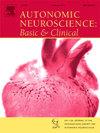遥控迷走神经刺激在急性心肌梗死大鼠模型中减轻室性心律失常和防止心力衰竭进展
IF 3.3
4区 医学
Q2 NEUROSCIENCES
引用次数: 0
摘要
背景:在自主神经系统失衡的驱动下,心肌梗死(MI)常导致室性心律失常和心力衰竭等并发症。本研究评估了一种新型遥控迷走神经刺激装置(VNS)的有效性,该装置在植入后具有可调节的刺激参数,特别关注其在急性心肌梗死大鼠模型中抑制室性心律失常和防止心力衰竭进展的潜力。方法随机选取小型Sprague-Dawley大鼠,通过结扎左前降支诱导心肌梗死。术后7 d,将大鼠分为3组:MI + VNS组(n = 15)、MI +对照组(n = 15)和假手术组(n = 12)。在MI + VNS组,植入VNS装置,初始刺激设置为0.2 mA, 0.2 ms脉宽,20 Hz频率。在随访期间,调整刺激参数以保持心率比基线降低5 - 20%。植入VNS后4周评估心功能、心律失常诱发性和心肌纤维化。结果与MI +对照组相比,远程控制VNS可显著改善左心室射血分数和分数缩短(P <;0.001)。左心室收缩末期直径明显减小(P = 0.003)。此外,vns治疗的大鼠室性心律失常的发生率和持续时间较低(P = 0.003),心肌纤维化减少(P <;0.001)。与对照组相比,VNS组血浆b型利钠肽和去甲肾上腺素水平也显著降低(P <;0.001)。结论遥控VNS为治疗心肌梗死相关并发症提供了一种新颖、动态的方法。远程控制的VNS通过对实时生理变化的适应性刺激,可能是降低心肌梗死后心力衰竭和心律失常风险的一种有价值的策略。本文章由计算机程序翻译,如有差异,请以英文原文为准。
Remote-controlled vagal nerve stimulation attenuates ventricular arrhythmias and prevents heart failure progression in a rat model of acute myocardial infarction
Background
Myocardial infarction (MI) often leads to complications like ventricular arrhythmias and heart failure, driven by autonomic nervous system imbalance. This study evaluates the effectiveness of a novel remote-controlled vagal nerve stimulation (VNS) device, featuring adjustable stimulation parameters post-implantation, specifically focusing on its potential to inhibit ventricular arrhythmias and prevent the progression of heart failure in a rat model of acute MI.
Methods
Male Sprague-Dawley rats were randomized, and MI was induced by ligation of the left anterior descending artery. Seven days post-MI, rats were divided into three groups: the MI + VNS group (n = 15), the MI + control group (n = 15), and a sham-operated group (n = 12). In the MI + VNS group, a VNS device was implanted with initial stimulation settings of 0.2 mA, 0.2 ms pulse width, and 20 Hz frequency. During follow-up, stimulation parameters were adjusted to maintain a 5–20 % reduction in heart rate from baseline. Cardiac function, arrhythmia inducibility, and myocardial fibrosis were assessed four weeks after VNS implantation.
Results
Remote-controlled VNS significantly improved left ventricular ejection fraction and fractional shortening compared to the MI + control group (all P < 0.001). The left ventricular end-systolic diameter was also significantly reduced (P = 0.003). Additionally, VNS-treated rats exhibited a lower incidence and duration of ventricular arrhythmias (P = 0.003) and a reduction in myocardial fibrosis (P < 0.001). Plasma levels of B-type natriuretic peptide and noradrenaline were also significantly lower in the VNS group compared to controls (all P < 0.001).
Conclusions
These findings suggest that remote-controlled VNS offers a novel and dynamic approach to treating MI-related complications. By allowing for adaptive stimulation in response to real-time physiological changes, remote-controlled VNS may represent a valuable strategy for reducing the risk of heart failure and arrhythmias post-MI.
求助全文
通过发布文献求助,成功后即可免费获取论文全文。
去求助
来源期刊
CiteScore
5.80
自引率
7.40%
发文量
83
审稿时长
66 days
期刊介绍:
This is an international journal with broad coverage of all aspects of the autonomic nervous system in man and animals. The main areas of interest include the innervation of blood vessels and viscera, autonomic ganglia, efferent and afferent autonomic pathways, and autonomic nuclei and pathways in the central nervous system.
The Editors will consider papers that deal with any aspect of the autonomic nervous system, including structure, physiology, pharmacology, biochemistry, development, evolution, ageing, behavioural aspects, integrative role and influence on emotional and physical states of the body. Interdisciplinary studies will be encouraged. Studies dealing with human pathology will be also welcome.

 求助内容:
求助内容: 应助结果提醒方式:
应助结果提醒方式:


